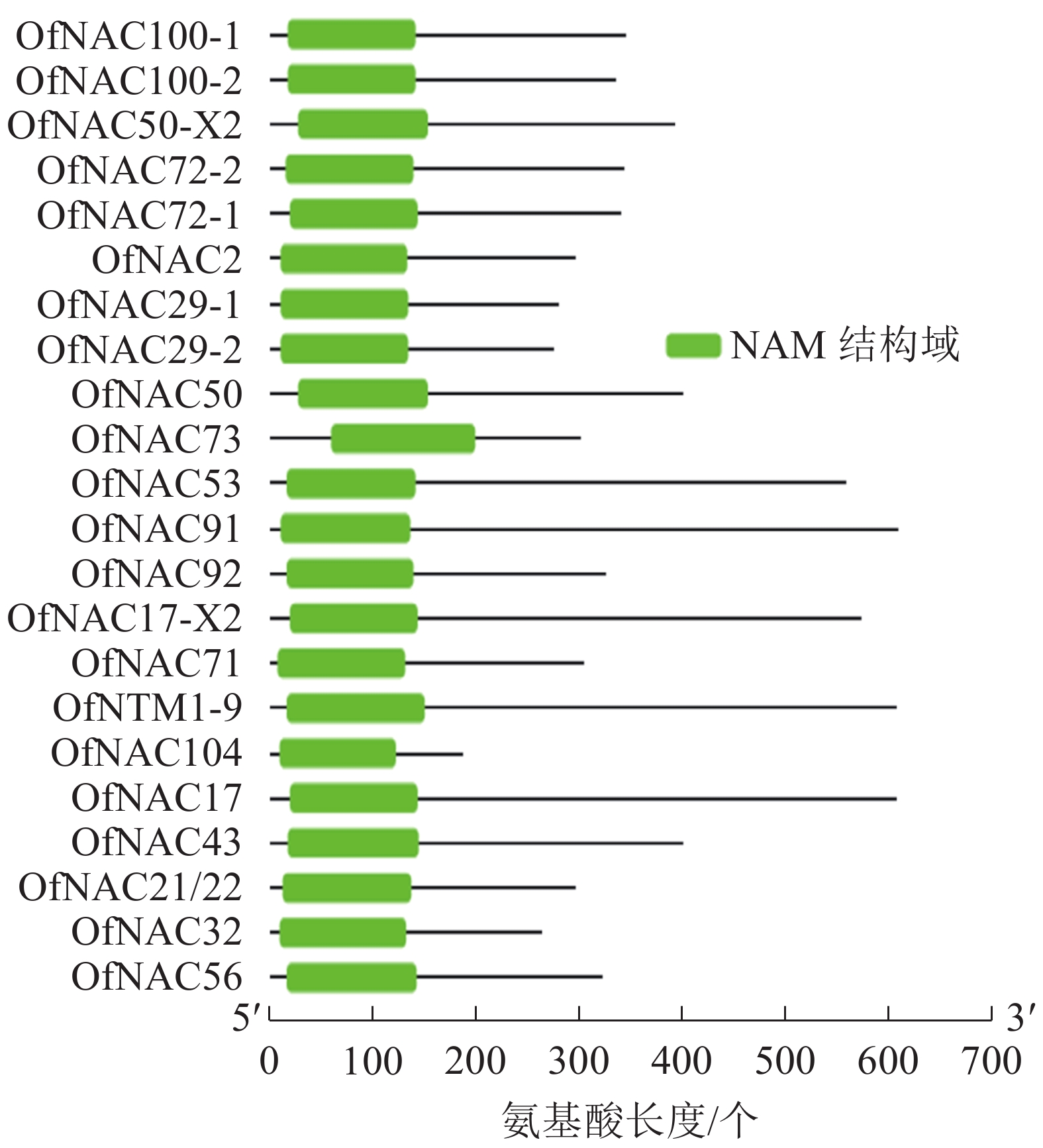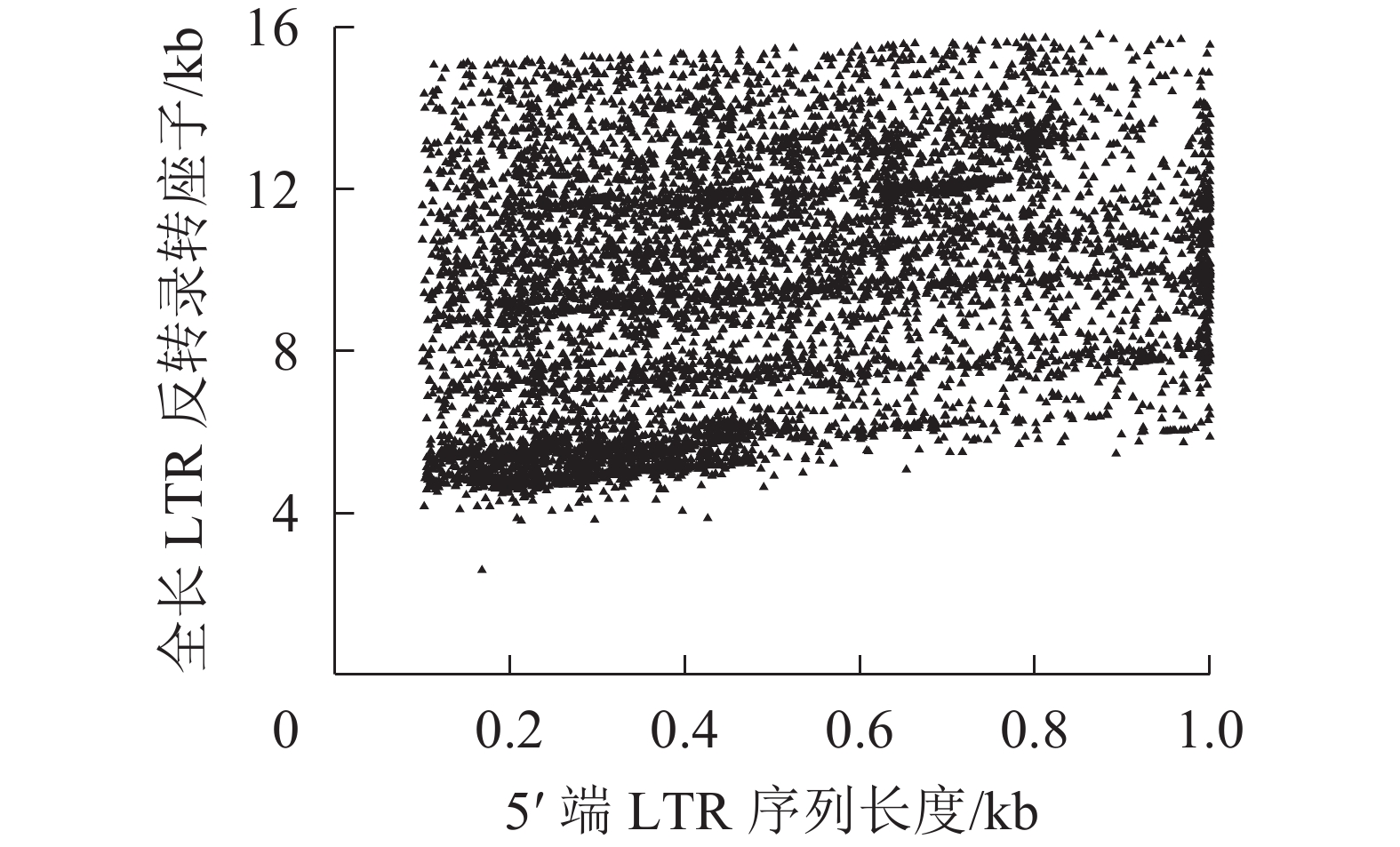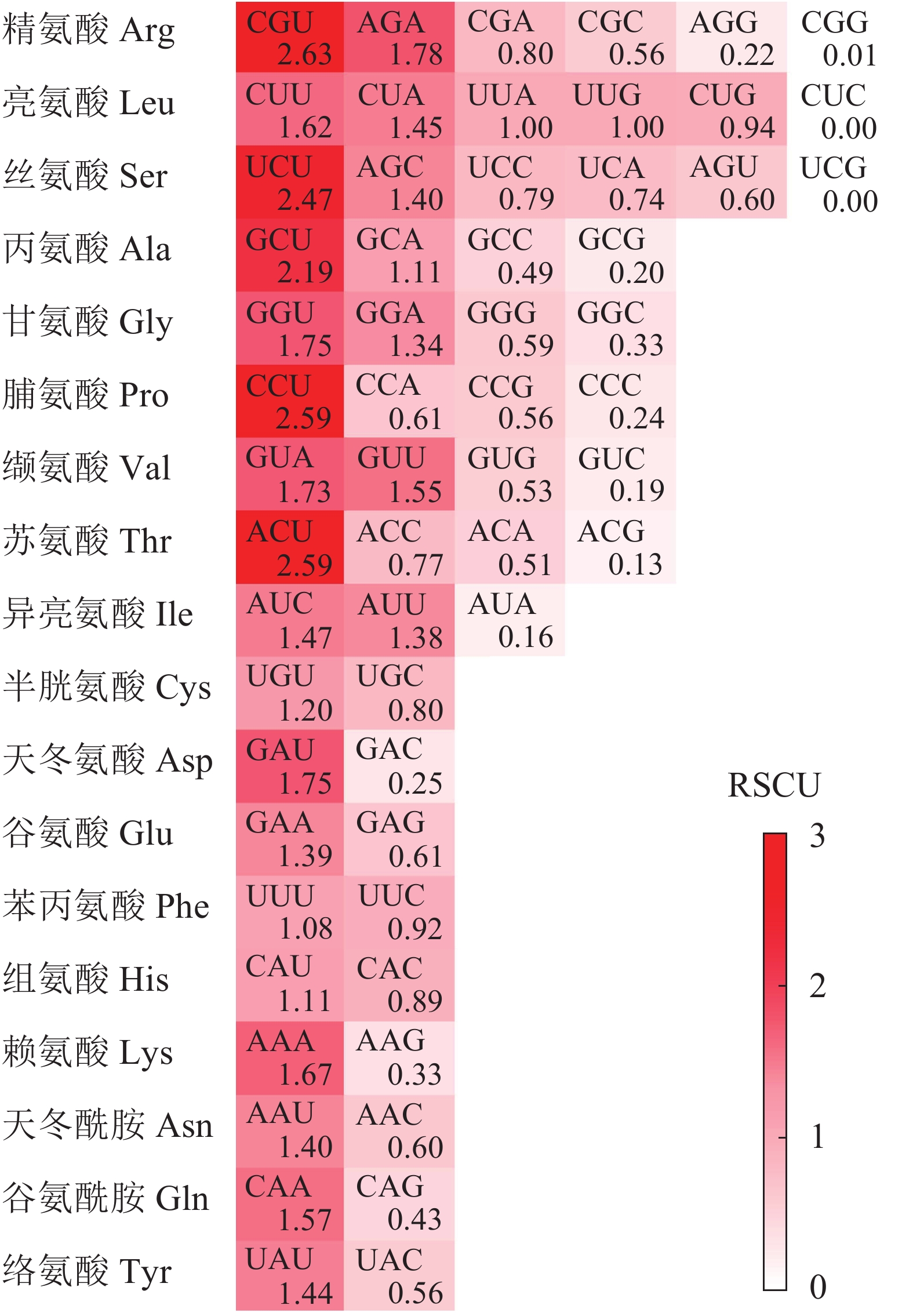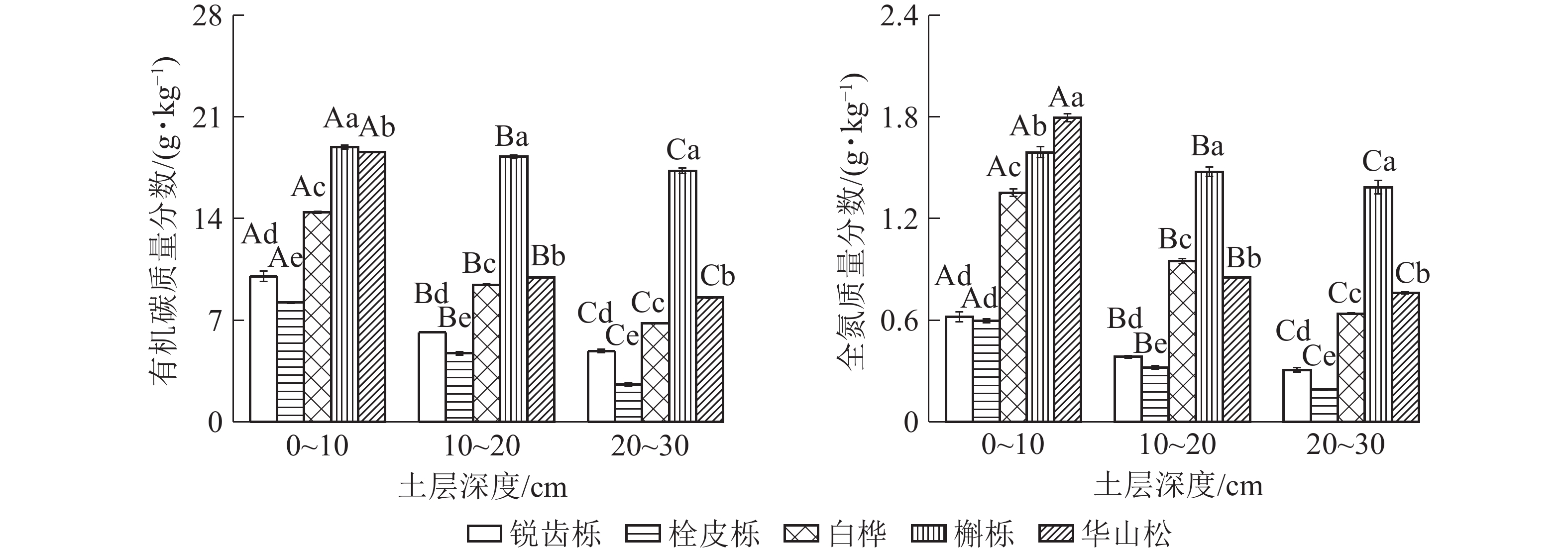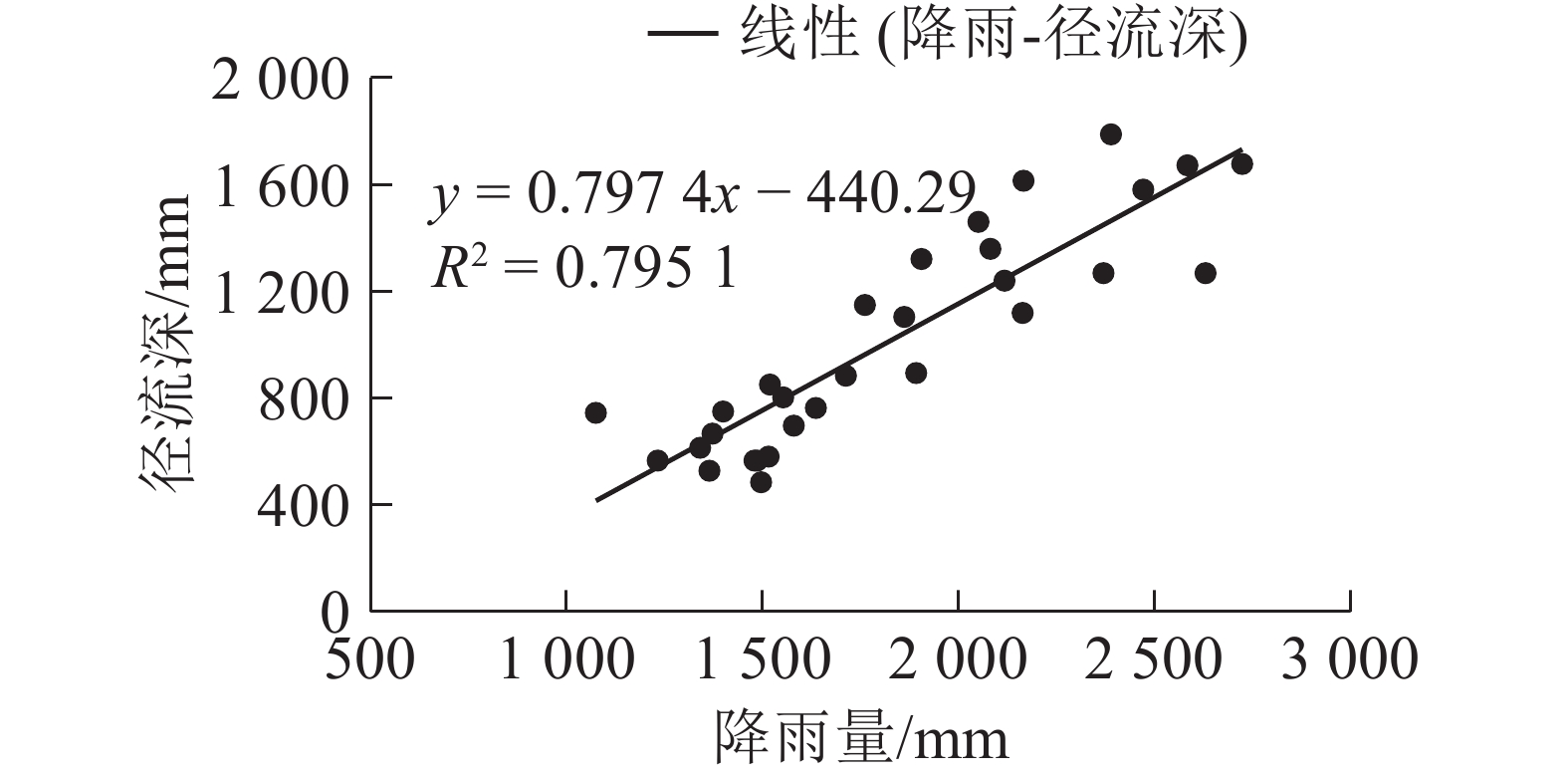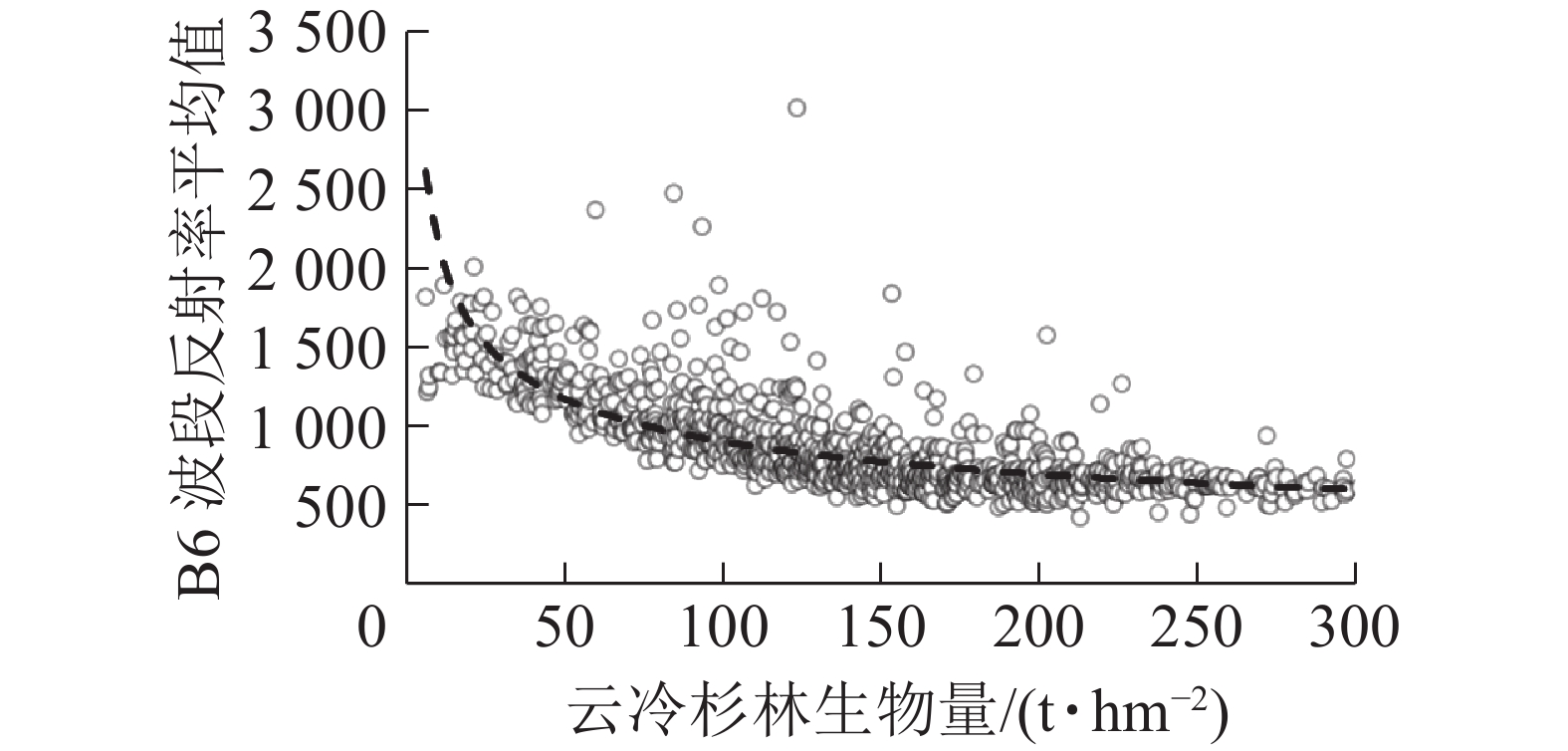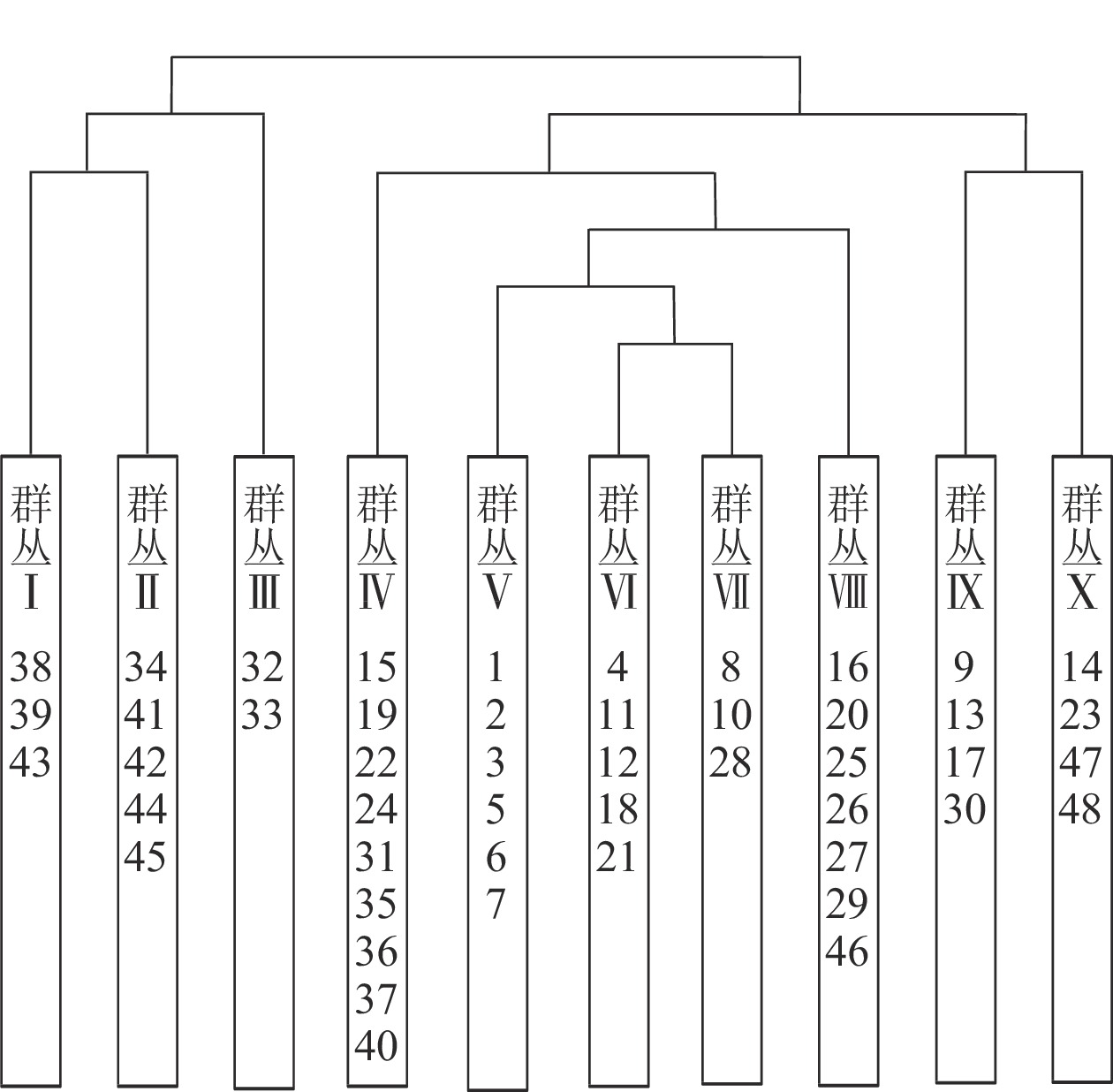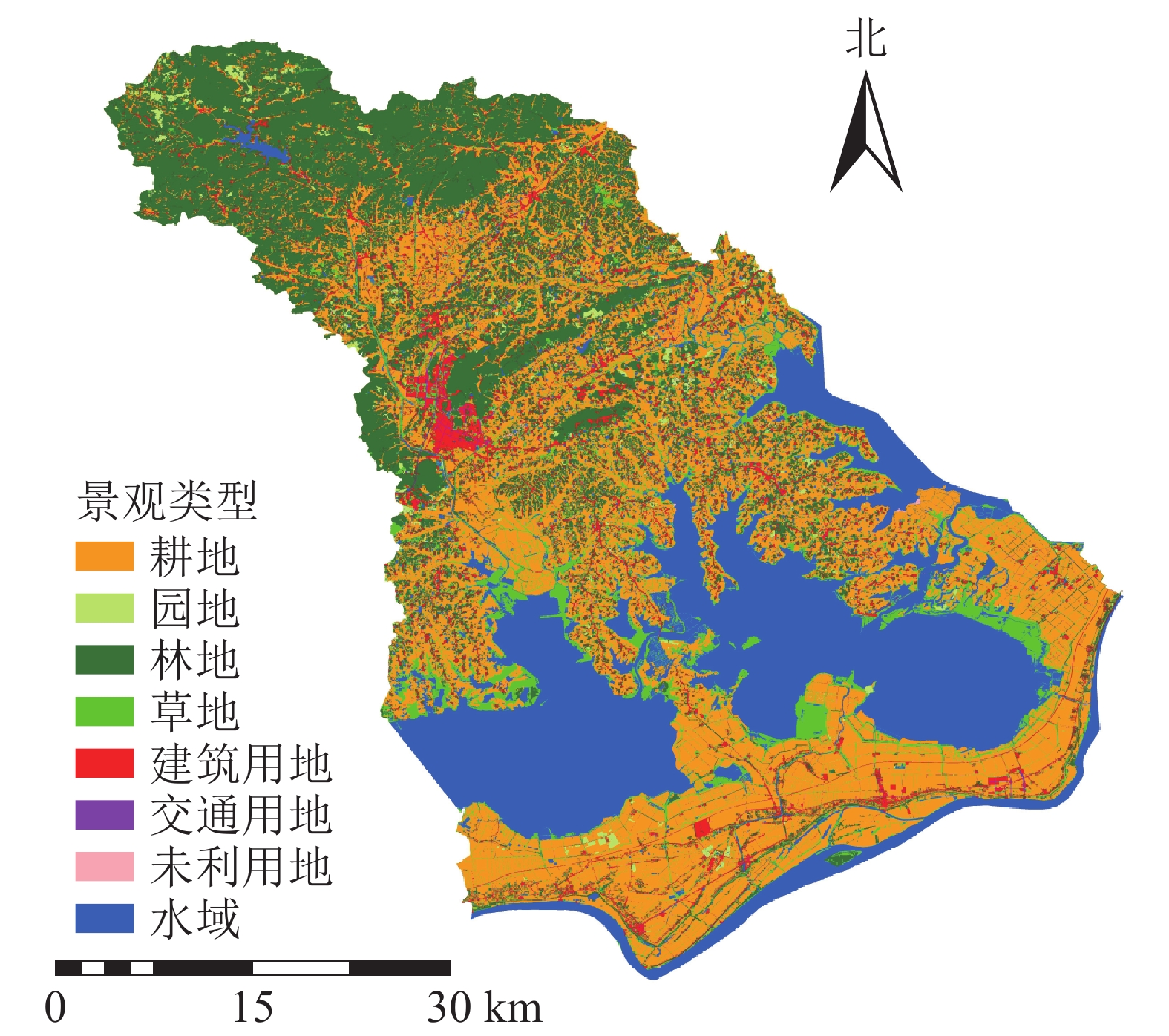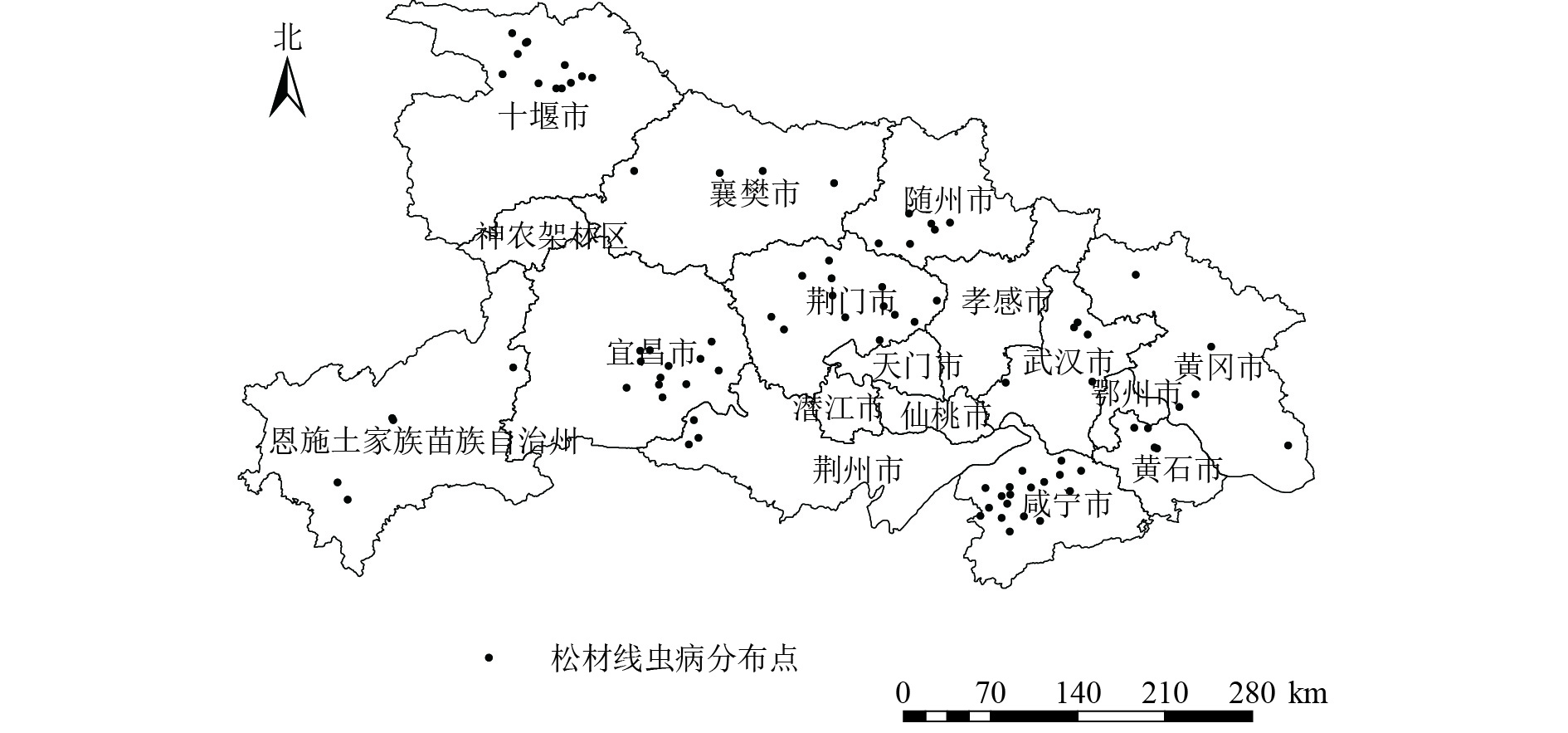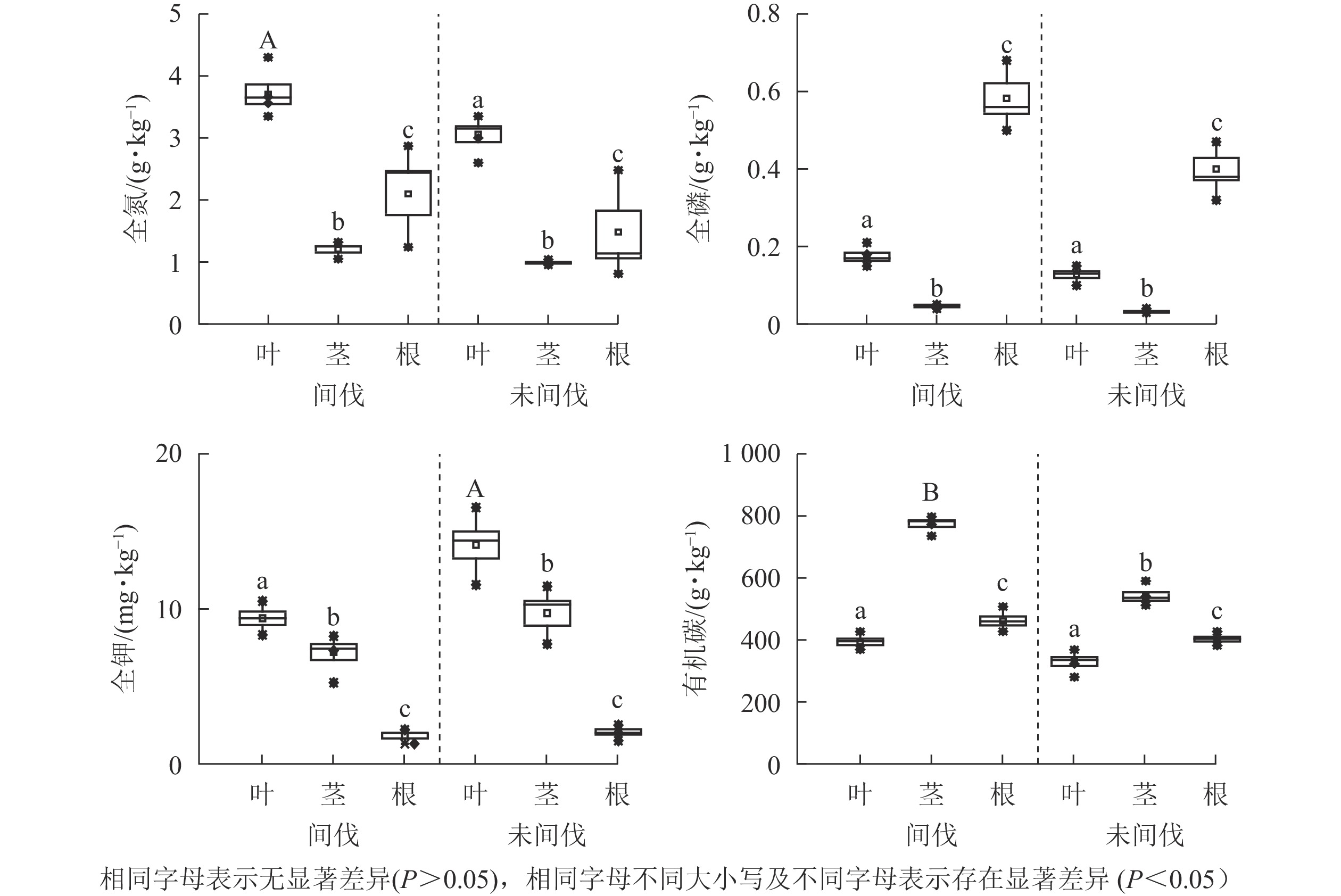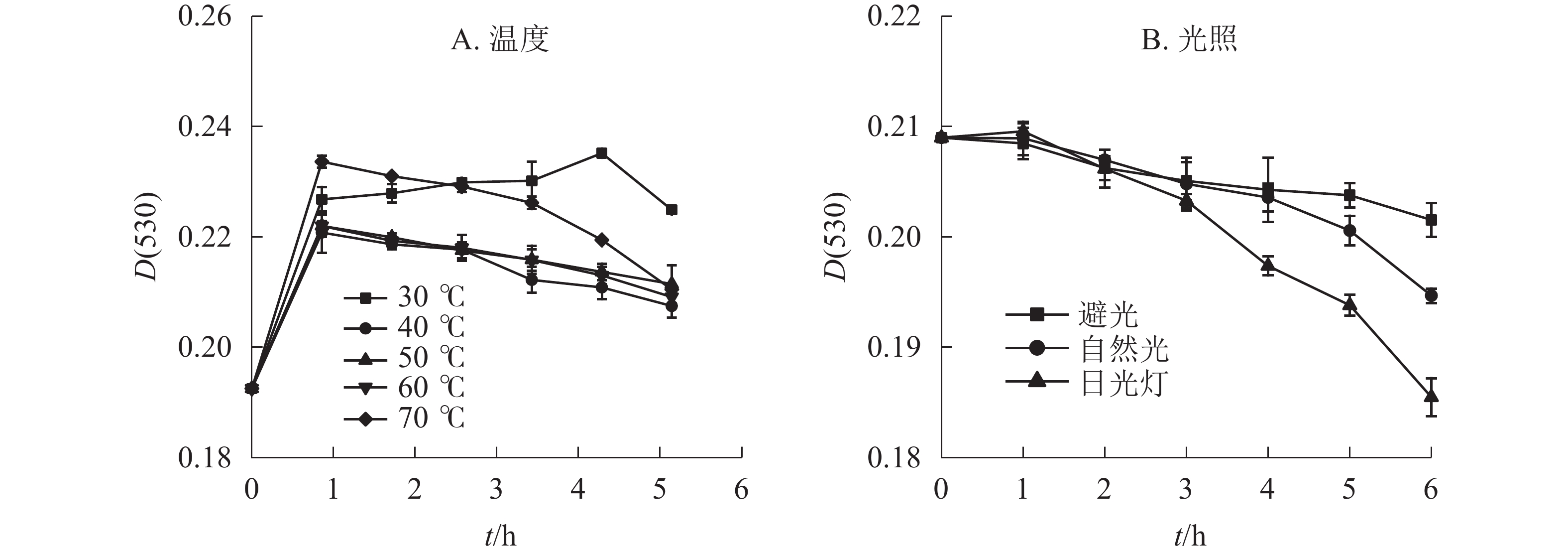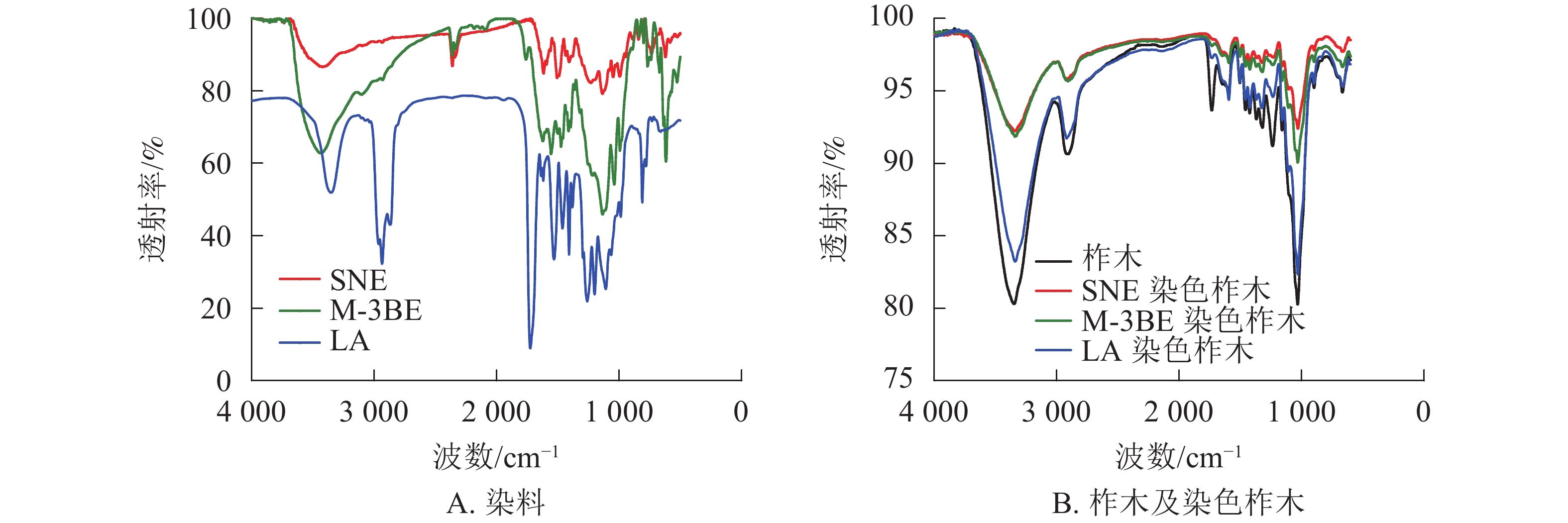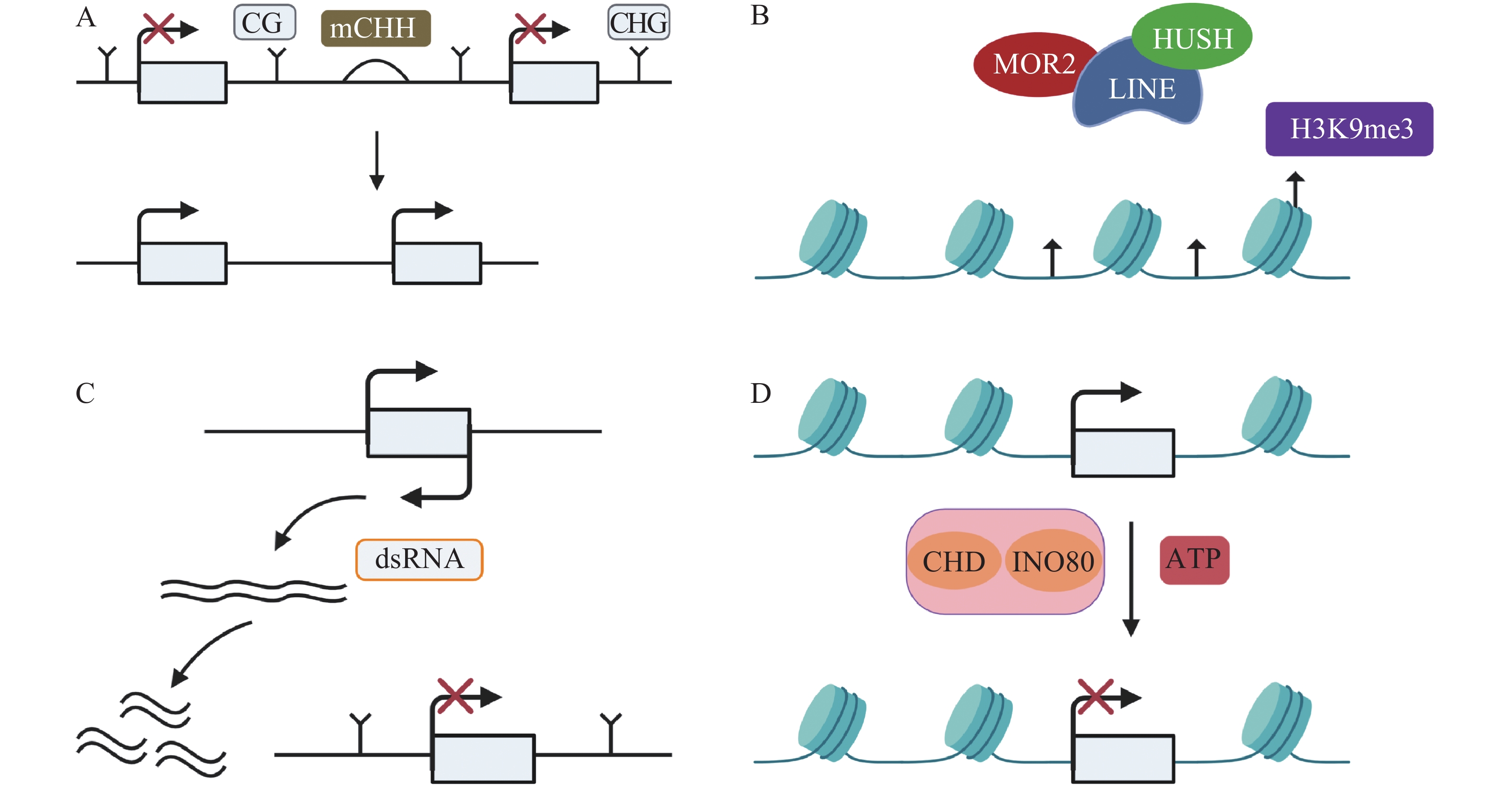2021 Vol. 38, No. 3
column
2021, 38(3): 433-444.
doi: 10.11833/j.issn.2095-0756.20200474
Abstract:
Objective This study aims to investigate the regulation of OfNAC genes on flower opening of Osmanthus fragrans. Method From the transcriptome data of O. fragrans ‘Yanhonggui’, the related OfNAC g enes were screened and analyzed to predict the physicochemical properties and structure. Real-time fluorescence quantitative PCR was used to analyze the expression characteristics of the flower opening process. Result 22 OfNAC sequences were screened from transcriptome. Bioinformatics analysis showed that all of the 22 OfNAC transcription factors contained NAM domains, and the amino acid sequence contained 5 conserved subdomains (A−E). The sequence of conservatism ranging from strong to weak was C, A, D, B, and E. The proportion of different structures in the secondary structure from large to small was random coils, α-helices, extended strands, and β-sheets. Subcellular localization and transmembrane structure prediction showed that OfNAC17, OfNAC17-X2, OfNAC53, OfNAC91, OfNTM1-9 were membrane-bound transcription factors, and most OfNACs were located in the nucleus. During the O. fragrans flowering process, the relative expression levels of OfNAC100-2, OfNAC43 and OfNAC73 reached the peak at the boll stem stage (S4), and then decreased. The relative expression of OfNAC43 was the highest at the boll stem stage (S4). The relative expression of OfNAC71, OfNAC29-1, and OfNAC21/22 increased slowly from the initial stage (S1), reached the highest at the apical shell stage, and then decreased as a whole. The relative expression of OfNAC29-2 increased sharply at the bead stage (S2) and reached the lowest at the boll stem stage (S4). Conclusion It is speculated that OfNAC100-2, OfNAC43, OfNAC73, OfNAC71, OfNAC29-1, OfNAC21/22, OfNAC29-2 may be involved in the regulation of O. fragrans flower opening. [Ch, 6 fig. 3 tab. 33 ref.]
2021, 38(3): 445-454.
doi: 10.11833/j.issn.2095-0756.20200488
Abstract:
Objective The shading caused by the community is one of the important factors that lead to the endangerment of Magnolia sinostellata. Therefore, it is important to conduct a systematic analysis and research of PIF family transcription factors which play an important role in light signal transduction and plant growth. Also, such analysis will help lay a foundation for the exploration of its role in the light signal transduction mechanism of M. sinostellata. Method With the transcriptome data of M. sinostellata collected, transcription factors of PIF family were identified and analyzed by bioinformatic while the expression patterns were analyzed employing the qRT-PCR technology. Result The nine MsPIFs transcription factor genes screened from the M. sinostellata enjoyed a length of 188−735 aa, a protein size of 20314.56−78957.02 Da, and a theoretical isoelectric point range of 5.18−8.22. The proteins encoded by MsPIFs gene were unstable proteins, and all proteins were hydrophilic proteins localized in the nucleus as was demonstrated in the subcellular localization prediction. All nine proteins have Ser, Thr and Try phosphorylation sites. As was shown in the qRT-PCR results, under extreme shading conditions, there was the occurrence of changes of different degrees in the gene expression of 9 MsPIFs families of which MSBHLH23 has an expression level that was 52.77 and 20.03 times higher than that of the control at 5 d and 10 d after shading treatment. Conclusion The PIF transcription factor family of M. sinostellata can respond to shading and this study has laid a foundation for the identification of MsPIFs biological function. [Ch, 7 fig. 3 tab. 32 ref. ]
2021, 38(3): 455-463.
doi: 10.11833/j.issn.2095-0756.20200458
Abstract:
Objective This study aims to analyze the characteristics of long terminal repeat retrotransposons (LTR-REs) in moso bamboo genome, so as to promote the research on the function of LTR-REs in moso bamboo genome and the genetic diversity of bamboo resources. Method Based on bioinformatics methods, LTR retrotransposons in the second edition of moso bamboo genome were annotated and classified by LTRharvest and RepeatMakser software, and the distribution characteristics, evolution characteristics and insertion time of the obtained LTR retrotransposons were analyzed. Result A total of 1 014 565 LTR retrotransposons and 1 562 families were identified, accounting for 54.97% of moso bamboo genome. Among them, the ratio of solo LTR retrotransposons to intact LTR retrotransposons (S/F) was relatively high (about 1.77∶1.00), indicating that a higher frequency of illegitimate recombination and unbalanced recombination might have occurred in the LTR-REs of moso bamboo genome. LTR retrotransposons were divided into Ty1-copia and Ty3-gypsy superfamilies, and ten lineages included Tork, Reftrofit, Sire, Oryco, Del, Reina, Crm, Tat, Galadriel, and Athila. The preference of Ty1-copia and Ty3-gypsy superfamiles for PBS sites showed an opposite tendency. The longer LTR retrotransposons had longer LTR sequences and more complete structures. The insertion time of LTR retrotransposon in moso bamboo was mainly concentrated in the 0−2.0 Ma region, and it was still in a state of slow growth. Conclusion The high-quality assembly of the second edition of moso bamboo genome can better annotate and analyze the LTR retrotransposons in moso bamboo genome. The LTR harvest method based on structure prediction can more accurately predict the LTR retrotransposons of moso bamboo. The LTR retrotransposons of different lineages have different differentiation and amplification activities during evolution. LTR retrotransposons are generally in a state of continuous amplification, which is one of the reasons for the large genome of moso bamboo. [Ch, 3 fig. 3 tab. 52 ref.]
2021, 38(3): 464-475.
doi: 10.11833/j.issn.2095-0756.20200454
Abstract:
Objective This study is aimed to investigate the structural features and the evolutionary patterns of the LBD transcription factor family as well as their expression patterns throughout the embryonic development in Carya illinoensis. Method With bioinformatic software employed, efforts were made to identify the LBD gene and analyze its gene structure characteristics, phylogeny relationships and evolutionary history in flower plants, as well as their expression patterns at the three key stages througout the embryonic development. Result Within the whole genome in C. illinoensis there were a total of 52 candidate LBD genes which, in terms of gene structure, maximum likelihood phylogenetic tree and motif analysis, could be classified into 3 categories: Group Ⅰ, Group Ⅱ and Group Ⅲ. After the multiple sequences alignment analysis three important structures in the LOB domains of 52 LBD genes were identified, namely the CX2CX6CX3C zinc finger structure, the highly conserved glycine GAS structure and the leucine zipper-like structure with the occurrence of specific mutations or deletions in each of them. According to the LBD gene family phylogenetic analysis of representative flowering plants, Group Ⅰ and Group Ⅱ are relatively conservative, while all LBD genes in Group Ⅲ share a longer branch which indicates that they have undergone greater variation and new functions have been differentiated. The expression analysis showed that the LBD gene family participates in the function of regulating the development of embryos, usually with control over the development and morphogenesis of cotyledons and there is a cluster of genes in the LBD gene of hickory pecans that are highly expressed during the entire embryo development process playing a highly significant role. Conclusion A total of 52 LBD genes were obtained in the whole genome of C. illinoensis, which can be divided into three different subfamilies with different gene structures, protein structures, evolutionary patterns, and expression patterns, and these subfamilies, according to the transcriptome expression analysis, are differentially expressed at different stages of embryonic development, and involved in the regulation of C. illinoensis embryo development collectively. [Ch, 5 fig. 2 tab. 47 ref.]
2021, 38(3): 476-484.
doi: 10.11833/j.issn.2095-0756.20200390
Abstract:
Objective With an analysis of the codon usage characteristics of the rbcL genes in Lythraceae species, this study is aimed to clarify the influencing factors of codon bias, and screen the optimal receptor for heterologous expression and genetic transformation. Method After rbcL gene CDS of 20 Lythraceae species were obtained from NCBI, CodonW, EMBOSS, and DAMBE software were utilized to compute relevant parameters of gene base composition and codon usage bias before an analysis is conducted of the usage bias of such genes and its incluencing factors using SPSS and Origin software. Result The GC content of the rbcL gene from Lythraceae species ranged from 0.425 to 0.437, with GC3s being 0.275 to 0.300 and there was a significant correlation between GC3s, GC, and ENC(P<0.01). As was shown in the analysis of ENC-GC3s plot, the neutral plot and PR2, natural selection pressure affected the codon usage bias of the rbcL gene from Lythraceae species more heavily than mutation pressure. The result of clustering analysis based on RSCU is partially consistent with that of the neighbor-joining tree based on CDS. Compared with the average codon usage frequency of the rbcL gene from the 20 Lythraceae species, Escherichia coli, Saccharomyces cerevisiae, Arabidopsis thaliana, Nicotiana tabacum, and Solanum lycopersicum possessed 28, 26, 20, 19 and 17 codons, respectively, with significant differences in usage frequency. Conclusion In terms of the base composition of the rbcL gene from 20 Lythraceae species, there was a tendency towards A/T bases and codons with A/T base at ther termonal were generally preferred. Also, of all the factors having an influence on codon bias, natural selection pressure was the most important one. Systematic clustering is a good complement for phylogenetic analysis. S. cerevisiae is more suitable as a heterologous expression receptor, while S. lycopersicum is more suitable to act as a receptor material for genetic transformation and function research of rbcL gene. [Ch, 6 fig. 3 tab. 32 ref.]
2021, 38(3): 485-493.
doi: 10.11833/j.issn.2095-0756.20200509
Abstract:
Objective The objective of this study is to explore the distribution characteristics of soil carbon and nitrogen under different vegetation types in Zibaishan National Nature Reserve, and analyze its main influencing factors. Method Soil samples were collected from different soil layers, including loam types (Q. aliena forest and P. armandii forest) and sandy types (Q. aliena var. acuteserrata forest, Q. variabilis forest, B. platyphylla forest). The content, density and storage of soil organic carbon (SOC), total nitrogen (TN), and carbon-nitrogen ratio (C∶N) under 5 different vegetation types were compared, and the relationship between SOC, TN, C∶N and soil physical and chemical properties was analyzed. Result (1)The content, density and storage of SOC and TN in the loam soil were significantly higher than those in the sandy soil (P<0.05). As for loam soil, Q. aliena forest had the largest content, density and storage of SOC and TN, followed by P. armandii forest. For sandy soil, the order from large to small was B. platyphylla forest, Q. aliena var. acuteserrata forest, and Q. variabilis forest. (2)With the increase of soil depth, the content, density and storage of SOC and TN in 0−30 cm soil layer decreased significantly (P<0.05). (3)Soil C∶N in different soil layers of different vegetation types showed little regularity or differences. The value of C∶N was 9.94−16.23, indicating strong mineralization ability of organic matter. (4)Soil water content (SWC) and bulk density (BD) were the main factors affecting soil SOC and TN content, while SWC and pH were the main factors affecting C∶N. Conclusion There are significant differences in content, density and storage of SOC and TN under different vegetation types, and SWC is a key factor affecting SOC, TN and C∶N. This study has a certain reference value for the protection and management of forest ecosystem in the reserve. [Ch, 4 fig. 5 tab. 36 ref.]
2021, 38(3): 494-501.
doi: 10.11833/j.issn.2095-0756.20200326
Abstract:
Objective With an examination of the effects of simulated nitrogen deposition and phosphorus addition on the soil respiration in Chinese fir(Cunninghamia lanceolata) forest, this study is aimed to provide scientific basis for the regulation of the soil carbon cycle in Chinese fir forest. Method In an attempt to investigate the changes in soil respiration in Chinese fir forest under atmospheric nitrogen deposition and phosphorus addition, a 10-year-old Chinese fir forest was selected as the research object with a total of 9 treatment levels, namely the control treatment group (ck), low nitrogen (N30: 30 kg·hm−2·a−1), high nitrogen (N60: 60 kg·hm−2·a−1), low phosphorus (P20: 20 mg·kg−1), high phosphorus (P40: 40 mg·kg−1), low nitrogen and low phosphorus (N30+P20), low nitrogen and high phosphorus (N30+P40), high nitrogen and low phosphorus (N60+P20), high high nitrogen and high phosphorus (N60+P40). Result The application of nitrogen and phosphorus had a significant effect on the respiration of Chinese fir soil. Nitrogen applied alone promoted the respiration of Chinese fir soil, to the largest degree (P<0.05) when the nitrogen level reached N60: 60 kg·hm−2·a−1. When the phosphorus level reached P40: 40 mg·kg−1, the soil respiration was most significantly promoted(P<0.05). With both nitrogen and phosphorus applied, the low nitrogen and high phosphorus treatment level (N30+P40) promoted the respiration most significantly. The soil respiration rate was extremely significantly positively correlated with soil temperature(P<0.01), and extremely significantly negatively correlated with the soil moisture(P<0.01). And at low nitrogen and low phosphorus treatment level (N30+P20), the soil temperature sensitivity coefficient(Q10) value was higher than the control. Conclusion Both nitrogen deposition and phosphorus addition can promote the soil respiration of Chinese fir and the combined application of nitrogen and phosphorus can promote the soil respiration of Chinese fir more significantly. Among all the treatment levels, the effect of high nitrogen and low phosphorus is the most significant. [Ch, 1 fig. 2 tab. 46 ref.]
2021, 38(3): 502-509.
doi: 10.11833/j.issn.2095-0756.20200505
Abstract:
Objective The study aims to explore the characteristics and laws of the chronological change of rainfall runoff and forest quality in Shicheng County of Jiangxi Province, and the relationship between rainfall, runoff and forest, so as to provide basis for quantitative monitoring and scientific evaluation of soil erosion and ecological environment in the red soil hilly area in southern China. Method Based on the natural rainfall and runoff sequence data of Shicheng County from 1989 to 2018 and remote sensing image maps in different years, the methods of wavelet analysis, remote sensing supervision and interpretation, and forest quality grade determination were employed. Result (1) Rainfall and runoff showed a slow downward trend with inter-annual changes, but the decreasing trend was not significant. (2) The forest quality index showed an upward-downward-upward trend with the increase of resolution years. (3) The improvement of forest quality had a significant role in flood detention. (4) The wavelet model of Shicheng County showed the runoff depth was positively correlated with precipitation and negatively correlated with forest quality index. Conclusion The improvement of forest quality can strengthen the ability of forest water conservation and forest flood detention. [Ch, 4 fig. 5 tab. 27 ref.]
2021, 38(3): 510-522.
doi: 10.11833/j.issn.2095-0756.20200327
Abstract:
Objective The objective of this study is to determine the saturation value of optical remote sensing estimation of spruce-fir forest biomass, and to improve the accuracy of remote sensing estimation of biomass. Method Taking the spruce-fir forests in Diqing Tibetan Autonomous Prefecture as the research object, the saturation value of the spruce-fir biomass was calculated by curve fitting, Tibetan Autonomous and the regression estimation model and BP neural network model of the spruce-fir biomass were established using the forest management inventory (FMI) data combined with Landsat 8 OLI remote sensing image in the contract period and the statistical value of remote sensing factor reflectance extracted from the randomly selected small class sample data. At the same time, based on the regression model, single level and nested two-level(region+age group)mixed effect models considering regional and age group effects were constructed to estimate the aboveground biomass of spruce-fir forests in the study area. Result The biomass saturation value of the spruce-fir forests in Diqing Tibetan Autonomous Prefecture was 233 t·hm−2 by power function fitting. The adjusted determination coefficient of the optimal regression estimation model \begin{document}$R_{\rm{a}}^{2}$\end{document} ![]()
![]()
\begin{document}$R_{\rm{a}}^{2}$\end{document} ![]()
![]()
Conclusion The mixed effect model has a wider estimation range, which can reduce the impact of low overestimation and high underestimation caused by data saturation, and improve prediction accuracy. [Ch, 3 fig. 12 tab. 28 ref.]
2021, 38(3): 523-533.
doi: 10.11833/j.issn.2095-0756.20200393
Abstract:
Objective The objective is to analyze the relationship between vegetation community and environmental factors in Jingzifeng National Forest Park of Qingyuan County, Zhejiang Province. Method Data of 48 quadrats in park were classified and sorted, and the relationship between forest community types, distribution characteristics and environmental factors was analyzed based on these data. Result (1)A total of 193 species belonging to 129 genera and 66 families were recorded in 48 plots. The families with abundant plant species were Fagaceae (19 species), Lauraceae (18 species), Theaceae (9 species), Ericaceae (9 species), Rosaceae (9 species), Aquifoliaceae (6 species), Gramineae (6 species), Rubiaceae (6 species), Chloranthaceae (5 species) and Liliaceae (5 species). The dominant species in tree layer included Cunninghamia lanceolata, Schima superba, Pinus taiwanensis, Cyclobalanopsis glauca, Castanopsis eyrei, Machilus thunbergii, Engelhardia fenzelii and Alniphyllum fortunei. The dominant species in shrub layer were Maesa japonica, Sarcandra glabra, Eurya muricata, and Rhododendron simsii. The dominant species in herbaceous layer were Pteridum aquilinum var. latiusculum, Dicranopteris dichotoma, Dryopteris fuscipes, Carex chinensis, Imperata cylindrica, Selaginella moellendorfii and Arthraxon hispidus. (2) TWINSPAN divided the vegetation community into 10 cluster types. (3) The distribution of the 10 clusters in DCA ordination diagram was regular, which reflected a good environmental gradient. (4) CCA ordination results showed that the most important environmental factor affecting the distribution of each cluster was altitude, followed by soil type, soil temperature and slope. The distribution characteristics of the dominant tree species were similar to those of each cluster. Conclusion Altitude is the most important environmental factor affecting the distribution of vegetation community in Jinzifeng National Park, and the altitude plays a decisive role in the distribution of mountain vegetation community. [Ch, 4 fig. 4 tab. 22 ref.]
2021, 38(3): 534-540.
doi: 10.11833/j.issn.2095-0756.20200455
Abstract:
Objective This study is aimed to clarify the three-dimensional green quantity (3DGQ) and the characteristics of forest recreation space (FRS) of landscape-recreational forests at different niches, and reveal the rules of constructing landscape-recreation forests and the existing problems. Method On the basis of the community ecology theory, with 13, 14 and 26 sample plots selected from Qianshan Park, Zhuhai Institute of BIT, and Meihua City Park respectively as the subjects, each tree was surveyed using high-resolution remote sensing images before 3DGQ and FRS were calculated to analyze the differences between different location of landscape-recreation forests. Result Qianshan Park, located in the core urban area (CUA), had the lowest 3DGQ density. Michelia × alba, Ficus microcarpa, Cinnamomum camphora, Litchi chinensis, Khaya senegalensis, Ficus altissima, Delonix regia and Cinnamomum burmannii displayed high values of 3DGQ. The three sites showed different spatial distributions of 3DGQ, and Meihua City Park which was located in the core urban area had relatively even distribution of 3DGQ than the others. There was a positive correlation between DBH and 3DGQ, which was related to the crown shapes of trees. In terms of the spatial allocation, for D. regia, Ceiba speciose, Bombax ceiba and C. camphora, superiority was given to FRS, while for M. ×alba, various spatial allocation strategies were adopted. Conclusion The 3DGQ density decreases while the distribution of 3DGQ showed a strong central tendency with the location of landscape-recreational forests shifting from the core urban area to the sub-urban area (SUA) and finally to urban fringe area (UFA). The correlation coefficient between DBH and 3DGQ is related to the crown shapes of tree species and the features of different tree species in the progress of the construction of landscape-recreation forest should be taken into consideration in the allocation of canopy space and recreation space. [Ch, 3 fig. 1 tab. 30 ref.]
2021, 38(3): 541-551.
doi: 10.11833/j.issn.2095-0756.20200461
Abstract:
Objective The geographic national conditions data was used to quantitatively study the change trend of landscape ecological risk at the county scale. Method Based on the geographic and national conditions data supported by the GIS technology and Fragstats 4.2 software, the landscape index were selected and the geo-statistical methods were used to analyzed the dynamic changes of landscape, spatial-temporal changes of landscape ecological risks and human disturbance activities in Susong County from 2015 to 2017. Result In the northwest, landscape fragmentation, landscape separation, landscape fractional dimension, the level of landscape diversity and landscape ecological risks were all lower; In the central and southeast, landscape fragmentation, landscape separation, and landscape sub-dimension were higher which shows that the landscape distribution structure was more complicated, and the landscape ecological risk was higher; The low ecological risk areas, lower ecological risk areas, and medium ecological risk areas were decreasing, while the areas of higher ecological risk areas and high ecological risk areas were increasing. Conclusion From 2015 to 2017, the degree of landscape ecological risk in Susong County increased, and the ecological risk level was transformed from a lower level to an adjacent higher level. The ecological risk levels of mineral resource areas, fish and rice towns, transportation hub towns, agricultural areas, and mountain tourist areas were arranged in order from high to low. [Ch, 6 fig. 6 tab. 32 ref.]
2021, 38(3): 552-559.
doi: 10.11833/j.issn.2095-0756.20200351
Abstract:
Objective This research aims to understand the situation of invasive alien plants in Ningbo and assess their invasive risk levels, so as to provide suggestions for the ecological security management. Method Typical habitats of alien invasive plants in different areas of Ningbo were investigated by quadrats. The analytic hierarchy process (AHP) was used to comprehensively evaluate indexes such as introduction stage, suitable growth stage, diffusion stage, invasion distribution status, damage impact and management difficulty, so as to determine the invasive risk of the alien invasive plants. Result There were 77 species of alien invasive plants in Ningbo, belonging to 27 families and 58 genera. The dominant families of alien invasive plants were obvious, among which Asteraceae was the most, with 21 species, followed by Solanaceae, Leguminosae and Poaceae, with 6 species each. There were 71 species of herbaceous plants, accounting for 92.21% of the total species. 37 species were introduced intentionally, accounting for 48.05% of all invasive plants. 32 species were unintentionally introduced, accounting for 41.56%. There were 8 species (10.39%) whose invasive routes were unknown, accounting for 10.39%. 58 species came from America, accounting for 75.32% of the total number of alien invasive plants in Ningbo. 15 were from Europe (19.48%). AHP showed there were 15 species of alien invasive plants with level Ⅰ risk, 14 species with level Ⅱ risk, 18 species with level Ⅲ risk, 22 species with level Ⅳ risk and 8 species with level Ⅴ risk. Conclusion The risk level of alien invasive plants in Ningbo is relatively high. It is suggested that comprehensive measures should be taken to prevent and control the invasive harm of the alien plants according to the assessed risk level. [Ch, 2 tab. 28 ref.]
2021, 38(3): 560-566.
doi: 10.11833/j.issn.2095-0756.20200365
Abstract:
Objective The epidemic situation of Bursaphelenchus xylophilus in Hubei Province is severe. The objective of this study is to investigate the invasion risk and the damage degree of B. xylophilus disease in Hubei Province, so as to provide suggestions and reference for current epidemic prevention and control. Method Combined with 3S technology, the ecological niche factor analysis (ENFA) model was used, and 4 factors affecting the colonization and spread of B. xylophilus (climate, vegetation, terrain, human disturbance) were selected to predict and evaluate the invasion risk of the disease. Result The high risk area of B. xylophilus disease in Hubei Province covered an area of 38 884.62 km2, accounting for 20.92% of the total area of Hubei Province, mainly concentrated in the central and eastern regions with low altitude and frequent human activities. The moderate risk area was 66 501.84 km2, representing 35.77% of the total area. The low risk area was 80 513.54 km2, representing 43.31% of the total area. These areas were mainly distributed in Jianghan Plain and high-altitude mountains in the west. B. xylophilus preferred to be distributed in coniferous forest areas with high temperature, abundant precipitation, low altitude, close to human settlements and frequent human activities. Through cross-validation to test the prediction of the model, the P/E curve was obtained. The curve was monotonically increasing and the Boyce index was very high, indicating that the model had high accuracy. Conclusion The ENFA model can simulate the risk areas of B. xylophilus. The results of the model can provide reference for the prevention and control of B. xylophilus in Hubei Province. [Ch, 2 fig. 3 tab. 25 ref.]
2021, 38(3): 567-576.
doi: 10.11833/j.issn.2095-0756.20200551
Abstract:
Objective The objective of this study is to explore the effect of thinning on the functional traits of roots, stems and leaves of Vitex negundo var. heterophylla under Quercus variabilis plantation in order to provide theoretical basis for the optimization of plantation structure and the regeneration and protection of understory seedlings. Method The V. negundo var. heterophylla in the shrub layer of Q. variabilis plantation 3 years after thinning was taken as the research object, and the differences of leaf area, specific leaf area, leaf dry matter content, stem dry matter content, total root length, specific root length and other structural traits, as well as total nitrogen, total phosphorus, total potassium and total organic carbon content in various plant organs were compared. The relationship between plant functional traits and the understory light environment and soil physical and chemical characteristics was studied. Result After thinning, the aboveground functional traits of plants of V. negundo var. heterophylla such as total leaf organic carbon, leaf area, specific leaf area, leaf organic nitrogen, stem total organic carbon, and the underground functional traits of plants such as root length, root volume, root biomass, the total organic carbon content of roots were significantly higher than those of the control plot (P<0.05). Correlation and stepwise regression analysis results showed that scattered radiation was the main factor affecting the structural properties of V. negundo var. heterophylla leaves. Direct radiation flux, photosynthetically active radiation and total solar radiation time were the key factors affecting leaf chemical properties, while stem functional properties were mainly affected by the direct radiation and scattered radiation under the forest. Total root length, specific root length and root organic carbon content were significantly correlated with soil non-capillary porosity, soil total porosity, soil organic carbon and soil total nitrogen (P<0.05), among which soil organic matter content was the key factor affecting functional traits. Conclusion Thinning can significantly promote the development of the functional traits of leaves and roots of Q. variabilis plantation, and has a weak effect on stem functional traits. [Ch, 1 fig. 6 tab. 31 ref.]
2021, 38(3): 577-586.
doi: 10.11833/j.issn.2095-0756.20200358
Abstract:
Objective This study aims to investigate the effects of water stress on the ultrastructure of chloroplast and the activity and content of key enzymes in the flavonoid synthesis pathway of Tetrastigma hemsleyanum, so as to improve the quality of T. hemsleyanum. Method With two-year-old seedlings of T. hemsleyanum as materials, and through water control pot experiments (setting waterlogging, drought, and the control), the effects of water stress on chloroplast ultrastructure, root flavonoid content and the activities of three key enzymes [phenylalanine ammonia lyase(PAL), chalcone synthase(CHS) and chalcone isomerase(CHI)] in flavonoid synthesis pathway were analyzed. Result Drought and waterlogging both caused the decrease of chloroplast number in the leaves, and they moved toward the center of the cell instead of clinging to the cell wall. Besides, the number of plastid globules in the chloroplast increased and the volume became larger, the color became lighter, and the lamella structure of chloroplast was no longer neat and compact. The total flavonoid content of T. hemsleyanum reached the peak on the 12th day under drought stress, and reached the peak on the 16th day under waterlogging stress. Analysis of key enzyme activities in the biosynthetic pathway of flavonoids showed that the activities of PAL, CHS and CHI increased successively in the early stage of the maximum flavonoid content or during the same period, but with the extension of stress time, the total flavonoid content and key enzyme activities decreased in varying degrees. There was a significant correlation between the content of flavonoids and the activities of PAL, CHS, and CHI (P<0.05). Conclusion Moderate water stress can increase the content of flavonoids in the roots of T. hemsleyanum and enhance the activity of related enzymes. [Ch, 7 fig. 1 tab. 36 ref.]
2021, 38(3): 587-596.
doi: 10.11833/j.issn.2095-0756.20200291
Abstract:
Objective This study aims to investigate the composition of anthocyanins and the effects of physical and chemical factors on the stability of anthocyanins in Lycoris sprengeri. Method The anthocyanins in the flower were determined by liquid chromatography-mass spectrometry (LC-MS). The effects of temperature, light, pH value and metal ions on the color change of anthocyanins in L. sprengeri were studied by ultraviolet spectrophotometry and HPLC-ADA. Result (1) Cyanidin, pelargonidin and delphindin were the main components of anthocyanins in L. sprengeri. (2) The anthocyanin solution was stable when temperature was lower than 30 ℃, dark and pH value ≤ 3.0. High temperature, strong light and high pH value could degrade anthocyanins, and the degradation degree increased with time. Al3+, Fe2+, Cu2+ and Fe3+ all changed the color of anthocyanin solution, and Ca2+, Zn2+, Mg2+ and K+ had little effect on the color of anthocyanins, but the metal ion concentration of 0−0.01 mol·L−1 had a certain effect on the color of anthocyanins. Hyperchromic effect of Fe2+ was more obvious when Fe2+ concentration increased. (3) High temperature, strong light and pH value had some effects on the concentration of anthocyanins. The concentration of cyanidin 3-O-glucoside decreased with the increase of time, light and temperature, while that of pelargonidin-3-O-glucoside showed the opposite trend. Delphinidin-3-O-glucoside was stable under different light and temperature conditions. With the increase of pH value, the mass concentration of cyanidin-3-O-glucoside decreased gradually, while delphinidin-3-O-glucoside increased gradually. Conclusion The main components of anthocyanins in L. sprengeri are cyanidin, pelargonidin and delphinidin. High temperature, strong light and high pH value can degrade anthocyanins, which can lead to their structural transformation. [Ch, 7 fig. 1 tab. 29 ref.]
2021, 38(3): 597-604.
doi: 10.11833/j.issn.2095-0756.20200503
Abstract:
Objective This study aims to explore the formation mechanism and antibacterial effect of yak bone protein peptide-calcium chelate embedded with cinnamon essential oil, so as to make full use of the bone resource and improve its utilization rate and avoid serious waste. Method The yak bone was autoclaved at high temperature to separate protein and bone residue. Yak bone collagen peptide was obtained from enzymatic hydrolysis of protein, and soluble yak bone calcium was obtained from acid-dissolved bone residue. The cinnamon essential oil and the yak bone collagen peptide were mixed and homogenized to form a cinnamon essential oil-yak bone peptide emulsion, and the calcium chelate of yak bone protein peptide encapsulated in cinnamon essential oil was obtained by high speed shear method. The turbidity, particle size, polydispersity index, antibacterial activity of the chelated calcium were determined and organoleptic evaluation was conducted. Result The yak bone peptides were mostly small molecule peptides (less than 1.0 kDa), and were suitable for the preparation of chelated calcium. When pH value was less than 7, many yak bone peptides were negatively charged and were affected by hydrophobicity to form yak bone protein peptide-calcium chelates. The yak bone peptide was composed of a large number of proline (P) and glycine (G), which could easily form the β-turn, one of the polypeptide secondary structures, and facilitate the release of substances. The yak bone protein peptide-calcium chelate embedded with cinnamon essential oil had good stability, with an average particle size of 780.2 nm. The dispersibility was good and the polydispersity index was less than 0.2. The 12 h antibacterial rates of yak bone protein peptide, cinnamon essential oil and chelate against Aeromonas veronii were −13.70%, 70.24% and 77.33%, respectively. The inhibition rate of chelate to Aeromonas was higher than that of cinnamon essential oil after 6 hours. The organoleptic evaluation revealed that the aroma scores of chelate and cinnamon essential oil were 7.15 and 4.35 respectively, and the cinnamon flavor of chelate was significantly stronger than that of cinnamon essential oil (P<0.05), indicating that the chelate had a certain sustained-release effect. Conclusion Yak bone protein peptide and yak bone calcium are suitable for the development of complex amino acid mineral chelated calcium products, and the yak bone protein peptide-calcium chelate encapsulated with cinnamon essential oil can be used for the development of new antibacterial agents. [Ch, 4 fig. 4 tab. 33 ref.]
2021, 38(3): 605-612.
doi: 10.11833/j.issn.2095-0756.20200391
Abstract:
Objective This study is to analyze the applicability of low-alkali and low-salt reactive red dyes in veneer dyeing, with the purpose of reducing the pollution of dyeing wastewater and the cost of production. Method A new low-salt reactive red dye(SNE) and low-alkali reactive red dye(LA) were selected to dye Xylosma japonicum veneers with poor permeability. The widely used reactive red dye (M-3BE) was used as control. The substantivity, reactivity, fixation rate and dyeing effects were tested. Fourier transform infrared spectroscopy(FTIR), thermal gravimetric(TG) analyzer and scanning electron microscopy(SEM) were used to analyze the changes of functional groups, wood components and microstructure of specimens. Result Compared with M-3BE, when the dosages of Na2SO4 and Na2CO3 were reduced to 1/2 and 1/8 respectively, the fixation rate of SNE increased by 15.33% and color difference decreased by 1.35%, while the fixation rate of LA decreased by 3.37% and color difference increased by 2.03%. After dyeing, the hydroxyl content on the wood surface decreased, and the lowest hydroxyl content was detected on the X. japonicum wood surface dyed with SNE dyes. No new absorption peak was observed on the dyed X. japonicum veneers except weak sulfate S=O absorption peak. The mechanism and the functional group structure between three reactive dyes and wood were similar. The thermal decomposition curves were slightly different due to differences in the parent structures of the three reactive dyes. All dye molecules could diffuse to the wood interior from the wood surface, and the order of diffusion degree from large to small was SNE, M-3BE, and LA. Conclusion SNE has high dye uptake and LA has excellent color effect, which can greatly reduce the discharge of electrolyte salt and alkali. [Ch, 3 fig. 3 tab. 28 ref.]
2021, 38(3): 613-623.
doi: 10.11833/j.issn.2095-0756.20200482
Abstract:
Global warming, a global ecological and environmental problem, attributes to the rapidly increased emission of greenhouse gases of which N2O ranks the third in the atmosphere after CO2 and CH4. On the one hand, nitrification and denitrification often take place in the process of forest soil nitrogen mineralization where N2O is produced from soils, thus, increasing the atmospheric N2O concentration. On the other hand, forest soil nitrogen mineralization, as a complex ecological process, is regulated by the interactions of biotic and abiotic environmental factors. Therefore, the investigation of the influencing factors and the regulatory mechanism of forest soil nitrogen mineralization, is conducive to the promotion of people’s understanding of the nitrogen cycling process of forest soils, thus playing an important role in the study of global change. However, previous studies on the nitrogen mineralization of forest soils were mainly limited to the effect of single factors with the lack of comparable research results, the cooperative regulation research on multiple factors (e.g., microbial-animal interaction), the study of forest soil nitrogen mineralization characteristics and impact mechanism under different circumstances of climate and land-use, and the research on the response of nitrogen mineralization to global climate change. Aimed to provide theoretical support for better understanding the spatiotemporal patterns of forest soil nitrogen mineralization in different climatic areas and their effects on global climate change, this study has conducted an examination of the spatiotemporal variations and the influencing factors of forest soil nitrogen mineralization, and provided an explanation of the characteristics and mechanism of the effect of abiotic (e.g., soil physicochemical environments) and biotic factors (e.g., forest vegetation cover, forest litter, and soil microorganisms and fauna) on forest soil nitrogen mineralization. It is advised that researches on soil nitrogen mineralization should, with unified and efficient methods, be focused on the influencing mechanism of the multi-factor coupling of soil microorganisms-fauna-environmental factors on forest soil nitrogen mineralization, the regulation mechanism of soil nitrogen mineralization under different climate and land-use circumstances, as well as the processes and mechanisms of forest soil nitrogen mineralization under the background of global change. [Ch, 69 ref.]
Global warming, a global ecological and environmental problem, attributes to the rapidly increased emission of greenhouse gases of which N2O ranks the third in the atmosphere after CO2 and CH4. On the one hand, nitrification and denitrification often take place in the process of forest soil nitrogen mineralization where N2O is produced from soils, thus, increasing the atmospheric N2O concentration. On the other hand, forest soil nitrogen mineralization, as a complex ecological process, is regulated by the interactions of biotic and abiotic environmental factors. Therefore, the investigation of the influencing factors and the regulatory mechanism of forest soil nitrogen mineralization, is conducive to the promotion of people’s understanding of the nitrogen cycling process of forest soils, thus playing an important role in the study of global change. However, previous studies on the nitrogen mineralization of forest soils were mainly limited to the effect of single factors with the lack of comparable research results, the cooperative regulation research on multiple factors (e.g., microbial-animal interaction), the study of forest soil nitrogen mineralization characteristics and impact mechanism under different circumstances of climate and land-use, and the research on the response of nitrogen mineralization to global climate change. Aimed to provide theoretical support for better understanding the spatiotemporal patterns of forest soil nitrogen mineralization in different climatic areas and their effects on global climate change, this study has conducted an examination of the spatiotemporal variations and the influencing factors of forest soil nitrogen mineralization, and provided an explanation of the characteristics and mechanism of the effect of abiotic (e.g., soil physicochemical environments) and biotic factors (e.g., forest vegetation cover, forest litter, and soil microorganisms and fauna) on forest soil nitrogen mineralization. It is advised that researches on soil nitrogen mineralization should, with unified and efficient methods, be focused on the influencing mechanism of the multi-factor coupling of soil microorganisms-fauna-environmental factors on forest soil nitrogen mineralization, the regulation mechanism of soil nitrogen mineralization under different climate and land-use circumstances, as well as the processes and mechanisms of forest soil nitrogen mineralization under the background of global change. [Ch, 69 ref.]
2021, 38(3): 624-633.
doi: 10.11833/j.issn.2095-0756.20200346
Abstract:
As part of the AP2/ERF superfamily, ethylene response factors (ERF) enjoys a structure featured with an AP2 domain and conserved motifs with different functions outside the AP2 domain. With previous reseaches, ERF positively regulates plant resistance under stress, but it can also negatively regulate plant resistance for certain reasons. ERF regulates fruit ripening by regulating the changes of pigment and softening and controls the longevity of flowers and leaves by regulating the process of senescence and abscission. ERF is regulated by signal molecules to start transcription, and then regulated by other mechanisms to complete the expression. ERF can achieve a wide-range regulation of the downstream genes by regulating signal molecules. The interaction between ERF and protein enriches the way in which ERF regulates downstream genes. And this study, based on what has been previously researched, is aimed to conduct a review of the structural characteristics, biological functions and expression regulation mechanism of ERF so as to provide a reference for future studies on ERF. [Ch, 1 fig. 1 tab. 77 ref.]
As part of the AP2/ERF superfamily, ethylene response factors (ERF) enjoys a structure featured with an AP2 domain and conserved motifs with different functions outside the AP2 domain. With previous reseaches, ERF positively regulates plant resistance under stress, but it can also negatively regulate plant resistance for certain reasons. ERF regulates fruit ripening by regulating the changes of pigment and softening and controls the longevity of flowers and leaves by regulating the process of senescence and abscission. ERF is regulated by signal molecules to start transcription, and then regulated by other mechanisms to complete the expression. ERF can achieve a wide-range regulation of the downstream genes by regulating signal molecules. The interaction between ERF and protein enriches the way in which ERF regulates downstream genes. And this study, based on what has been previously researched, is aimed to conduct a review of the structural characteristics, biological functions and expression regulation mechanism of ERF so as to provide a reference for future studies on ERF. [Ch, 1 fig. 1 tab. 77 ref.]
2021, 38(3): 634-643.
doi: 10.11833/j.issn.2095-0756.20200338
Abstract:
Transposable elements (TEs) can be moved by means of transposition or reverse transposition in the genome of an organism, whose copy number in large numbers is an important factor for genome instability. Therefore, it is the direction of host evolution to maintain TEs silence. DNA methylation, generally considered to be a heritable epigenetic modification method for silencing TEs, plays a role in the maintainance of genome stability, genetic imprinting and the regulation of gene expression. This study is aimed at an overview of the impact of TEs on the evolution of biological genome and gene expression, a summary of the latest research progress of transposon silencing mechanism dominated by DNA methylation, and an investigation of the mechanism of environmental factors that regulate transposon jumping via DNA demethylation. [Ch, 4 fig. 82 ref.]
Transposable elements (TEs) can be moved by means of transposition or reverse transposition in the genome of an organism, whose copy number in large numbers is an important factor for genome instability. Therefore, it is the direction of host evolution to maintain TEs silence. DNA methylation, generally considered to be a heritable epigenetic modification method for silencing TEs, plays a role in the maintainance of genome stability, genetic imprinting and the regulation of gene expression. This study is aimed at an overview of the impact of TEs on the evolution of biological genome and gene expression, a summary of the latest research progress of transposon silencing mechanism dominated by DNA methylation, and an investigation of the mechanism of environmental factors that regulate transposon jumping via DNA demethylation. [Ch, 4 fig. 82 ref.]
2021, 38(3): 644-651.
doi: 10.11833/j.issn.2095-0756.20200492
Abstract:
Objective The objective of this study was to screen the stable expression of internal reference genes of Melanotus cribricollis larvae infected by Metarhizium pingshaense, so as to lay a foundation for the research on related gene expression in this bamboo wireworm. Method Based on the transcriptome data of M. cribricollis larvae, the correlation (R2) and amplification efficiency were analyzed by qRT-PCR with specific primers. The 6 candidate reference genes including β-actin, GAPDH, α-tubulin, RPL13α, RPS3 and RPS27a were evaluated by GeNorm, NormFinder and BestKeeper softwares. The stabilities of selected candidate reference genes including PRS27a and RPS3 were further validated by analyzing the expression of 6 target genes. Result GeNorm analysis showed that the expression of PRS27a and RPS3 were the most stable, followed by α-tubulin, RPL13α, β-actin and GAPDH. The most suitable number of internal reference genes was 2. NormFinder analysis showed that the expression of RPL13α was the most stable, followed by α-tubulin, RPS3, RPS27a, β-actin, and GAPDH. BestKeeper analysis showed that the P values of β-actin and GAPDH were >0.5, which were not suitable for reference genes under the condition of this experiment. There were some differences in the ranking of candidate internal parameters obtained by different software analysis. Comprehensive analysis and expression stability verification showed that PRS27a or RPS3 were the best internal reference genes, and the expression levels of 6 target genes were basically the same. Conclusion PRS27a and RPS3 were the most appropriate reference genes for qRT-PCR analysis in bamboo wireworm infected by M. pingshaense. [Ch, 3 fig. 3 tab. 27 ref.]
2021, 38(3): 652-658.
doi: 10.11833/j.issn.2095-0756.20200302
Abstract:
Objective This paper with an analysis of the influencing factors of natural regeneration of Abies georgei var. smithii in Sejila Mountain, is aimed to provide theoretical guidance for the effective promotion of its natural regeneration. Method Based on a field sample survey as well as an analysis of the correlation between the seedlings density and the five influencing factors on shady and sunny slopes of A. georgei var. smithii in Sejila Mountain, the path analysis was carried out to find out the key factors affecting its natural regeneration. Result On both sunny and shady slopes, there was a significant positive correlation between the natural regeneration seedlings and the length of seed wing, 1000-seed weight, moss thickness, litter thickness, canopy density of sunny slope. Litter thickness was the most important factor affecting the growth of natural regeneration seedlings of A. georgei var. smithii on sunny slope and the order of contribution to seedlings density was litter thickness, 1 000-seed weight, moss thickness, winged seed length and canopy density. Moss thickness was the most important factor affecting the growth of natural regeneration seedlings of A. georgei var. smithii on shady slope and the order of contribution to seedlings density was moss thickness, litter thickness, 1000-seed weight, canopy density and winged seed length. Conclusion Litter thickness was the largest factor affecting the density seedlings of A. georgei var. smithii on sunny slope, while moss thickness on shady slope was the most critical factor. [Ch, 3 tab. 27 ref.]




